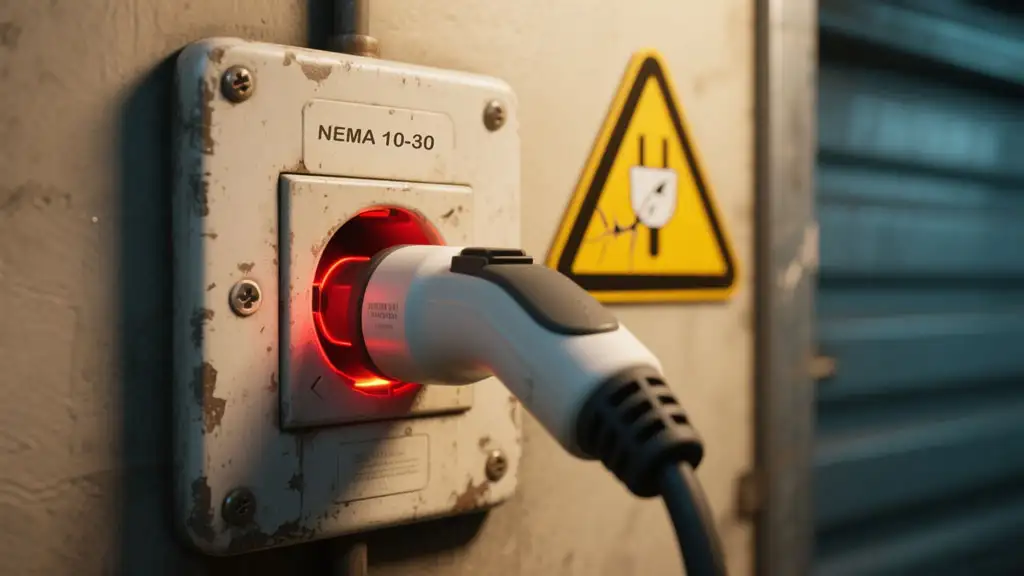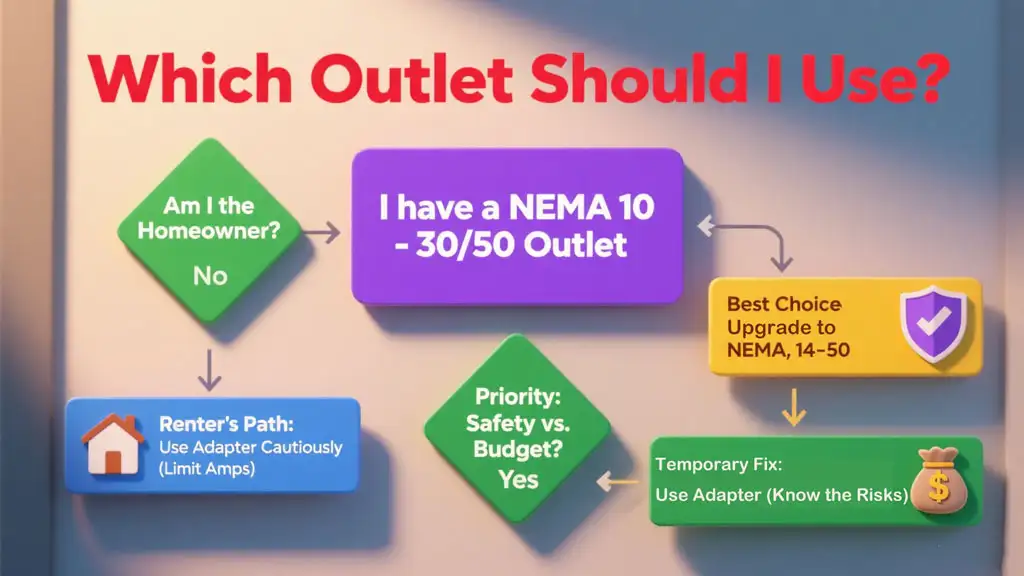
Congratulations on your new electric vehicle! Now you face one of the most practical questions: how to charge your EV at home? If you live in a house built before 1996, you might be staring at an old 3-prong NEMA 10-30 or 10-50 outlet for a dryer or electric range, wondering about the best home EV charger installation. So, let’s get straight to the answer: For the safety of you, your family, and your expensive electric vehicle, you should install a modern, 4-prong NEMA 14-50 outlet. While using an adapter to charge from your old 3-prong outlet is technically “possible,” it introduces serious safety risks you should not ignore. We will explain why NEMA 14-50 is the undisputed preferred option in the most concise and straightforward manner possible, comparing NEMA 10-30 vs 14-50, and provide you with all the necessary information to help you make the most informed decision.

The heart of the issue comes down to one simple difference: the ground wire.
NEMA 10-30 / 10-50: This is an outdated standard with only 3 prongs: two “hot” legs and one “neutral” leg. It lacks a dedicated ground connection.
NEMA 14-50: This is the modern safety standard with 4 prongs: two “hot” legs, one “neutral” leg, and one critically important dedicated ground pin.
The National Electrical Code (NEC) explicitly requires all new 240V outlet installations to be the 4-prong, grounded type for a reason: improved safety.
To visualize this, look at the table below:
| Feature | NEMA 10-30 / 10-50 | NEMA 14-50 (The Modern Standard) |
| Appearance | 3 slots in an “L” or straight line | 4 slots, with a half-round ground pin |
| Pin Definition | 2 Hot, 1 Neutral | 2 Hot, 1 Neutral, 1 Ground |
| Key Safety Lack | No separate path for ground fault | Includes a lifesaving safety ground |
| Code Compliance | Obsolete; no longer used for new installs | Meets all current electrical codes |
| Primary Risk | Higher risk of electric shock and fire | Risk minimized with GFCI protection |
| Charging Power | 5.7kW at 30A / 9.6kW at 50A | Up to 9.6kW at 50A |
As the global safety certification company UL Solutions emphasizes in its standards, “grounding is a fundamental safety measure for protecting users from the risk of electric shock.”¹ Your Electric Vehicle Supply Equipment (EVSE)—your charger—is engineered to operate on a circuit with a reliable ground.

Imagine the ground wire is your circuit’s “emergency exit.”
Under normal conditions, electricity flows stably between the hot and neutral wires. But if a fault occurs inside the equipment (like a frayed wire), the current can “leak” onto the device’s metal casing.
With a Ground Wire (NEMA 14-50): This dangerous stray current is instantly and safely directed to the earth through the ground wire, which will almost certainly trip your circuit breaker, cutting off the power in a fraction of a second. You and your car are safe.
Without a Ground Wire (NEMA 10-30): The stray current has nowhere to go. It energizes the casing of your charger, the charging handle, and even the metal body of your car. Anyone who then touches these parts can become the “emergency exit” for the current, leading to severe or even fatal electric shock.
The National Fire Protection Association (NFPA) reports that home electrical failures are a leading cause of house fires, with aging wiring and improper grounding being key factors.² Charging your EV is a high-power activity that lasts for hours, which magnifies any underlying risk in the circuit.
You can find many “NEMA 10-30 to 14-50″ adapters for sale online. They seem like the perfect solution. But you must understand how they work and the compromises they make.
These adapters create what is known as a “false ground” or “floating ground” by using an internal jumper wire to connect the ground pin of the 14-50 plug to the neutral terminal of the 10-30 outlet.
The Disaster of a Failed Neutral: This is the most dangerous scenario. If the neutral wire in your home’s circuit becomes disconnected somewhere, the current will seek another path back without a dedicated ground. This can energize your car’s chassis with up to 120 volts.
Lack of GFCI Protection: NEC Article 625 specifically calls for Ground Fault Circuit Interrupter (GFCI) protection for outlets used for EV charging. A GFCI detects tiny current leaks (long before a breaker would trip) and shuts off the power. Old 10-30 circuits are almost never protected by a GFCI.
Overburdened, Aging Wiring: A 30-amp circuit for a dryer may have been installed with decades-old wiring. Now you are asking it to continuously draw a heavy load for 6-8 hours to charge your EV, generating significant heat. Aging wires and connections can overheat, creating a fire hazard.
Leading manufacturers like Tesla explicitly recommend installing a NEMA 14-50 outlet in their official guidance for the best safety and charging experience.
Upgrading to a NEMA 14-50 is the fundamental way to solve all these problems. This is more than just swapping the faceplate on the wall.
Professional Assessment: A licensed electrician will check the capacity of your home’s electrical panel.
New Wiring: The electrician will run a brand new, thick 4-wire cable (2 hot, 1 neutral, 1 ground) from your panel to your garage or parking spot.
New Outlet and Breaker: A high-quality, industrial-grade NEMA 14-50 outlet (like Hubbell or Bryant brands) will be installed, along with a new 50A double-pole circuit breaker in your panel, preferably with GFCI functionality.
Absolute Safety: Full compliance with modern EV Charging Standards, giving you the highest level of protection.
Peace of Mind: Your EVSE can operate at its full power without you worrying about overheating or safety issues. No need to manually turn down the amperage on your charger.
Future-Proof Compatibility: The NEMA 14-50 is the “universal language” for Level 2 charging in North America. No matter what EV brand or charger you have in the future, it will be compatible. This is especially crucial for Apartment EV Charging Solutions to provide a standard interface for all residents.
Increased Property Value: A compliant, safe EV charging outlet is a clear selling point for a modern home.
When it comes to Home EV Charger Installation Cost, prices typically range from $400 to $1500, depending on the distance from your panel and the difficulty of the wire run. But this one-time investment buys you permanent peace of mind.

Use this simple checklist to help you decide:
Are the homeowner.
Plan to live in the house long-term (>2 years).
Put safety above all else.
Want the fastest, most reliable charging speeds.
Don’t want to worry or manually adjust settings for every charge.
Are thinking about the future value of your home.
Are a renter and cannot modify the property.
Are on an extremely tight budget AND you fully understand and accept the associated risks.
MUST commit to the following safety precautions:
Buy a high-quality, UL Certified adapter.
Manually limit your charging current to 24 amps (for a 30A circuit) in your car or charger every single time to follow the 80% rule.⁶
Your EVSE itself has advanced temperature and ground monitoring.
Highly Recommended: Even then, have an electrician inspect the circuit’s condition.
In the Hardwired vs Plug in EV Charger debate, a compliant NEMA 14-50 outlet gives you the flexibility to use a plug-in charger today and provides the robust circuit needed for an easy switch to a hardwired unit later. A proper EV Charging Station Design always begins with a safe and reliable power source.
While charging your EV with a NEMA 10-30 or 10-50 outlet and an adapter sounds like a money-saving shortcut, it bypasses critical protections developed over decades of electrical safety advancements.
Your electric vehicle is a major investment. More importantly, the safety of you and your family is priceless.
The final recommendation is crystal clear: Invest a few hundred dollars and have a qualified electrician install a proper, code-compliant NEMA 14-50 outlet. It is the only way you can go to sleep each night knowing your car is charging safely and efficiently. The peace of mind this investment provides is worth far more than its cost.
Have questions about upgrading your home EV charging setup? Need a professional assessment or a quote for NEMA 14-50 installation? Contact us today for a safe and reliable solution!
Yes, but it is strongly discouraged. You will need an official Tesla adapter or a high-quality third-party one, and you MUST manually limit the charging current to 24 amps in the car’s settings. You still face the risks of a missing ground and no GFCI protection.
The cost varies widely, typically from $400 to $1500. The main factors are the distance from your electrical panel to your garage, the complexity of the wire run (e.g., through finished walls), local electrician labor rates, and whether your panel needs an upgrade. Get 2-3 quotes from local licensed electricians.
The easiest way is to count the slots. A NEMA 10-30 has 3 slots. A NEMA 14-50 has 4 slots, with one being a half-round shape at the bottom. You can also look for the model number printed on the face of the outlet.
Before the NEC code was updated in 1996, 240V appliances like dryers and ranges were permitted to use the neutral wire as both the return path and the equipment ground. This was seen as a cost-saving measure. It was later deemed unsafe under certain fault conditions and was phased out.
The NEMA 14-50 is the most common plug for Level 2 (240V) plug-in chargers in North America. Nearly all brands of portable or plug-in chargers offer this option among their charger connector types. It is the de-facto “universal standard” for home charging.
Authoritative Sources
UL Solutions: https://www.shopulstandards.com/ProductDetail.aspx?productId=UL2594
National Fire Protection Association (NFPA): Home Electrical Fires Report
Mike Holt Enterprises (Electrical Code Experts): Grounding and Bonding Article 250 NEC
National Electrical Code (NEC) – Article 625: Electric Vehicle Charging System
Tesla, Inc.: Home Charging Installation Guide (The manufacturer’s official installation guide, which recommends a Wall Connector or a NEMA 14-50 outlet.)
U.S. Occupational Safety and Health Administration (OSHA): Grounding requirements (The federal agency’s requirements on grounding to protect against electric shock, underscoring its role in safety.)
We will send detailed technical info and quotation to you!